ZooPax
Birds of a Feather
Among living animals, feathers are unique
to birds. What is a feather? The most familiar type of feather is a flight
feather such as you might see in the wing of a flying bird. Flight feathers
look like this:
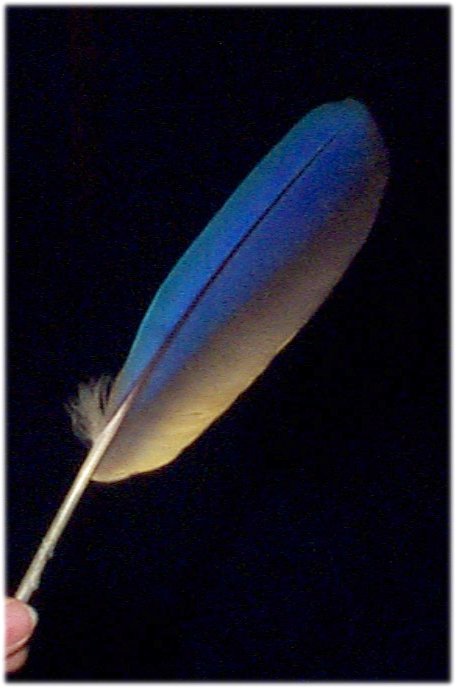
The feather shaft runs up the middle of the
feather, a little off center. On either side of the shaft is the large flat
feather vane. This is the flight surface. The vane of the feather is formed of
many individual feather barbs. Adjacent barbs are hooked together with a series
of microscopic hooks, like velcro. The hooks can be unzipped by pulling gently
on the barbs and zipped up again by running the barbs through your fingers.
Birds zip their feathers back up by preening -- running the bill over their
feathers. Contour feathers, which cover the body of a bird, are similar to
flight feathers, but broader and less asymmetrical. On the wings, body and
tail, the feathers are precisely overlapped to form a smooth flying
surface.
Feathers are made of a very light strong protein
called keratin. Birds also have keratin in their beaks and you have a type of
keratin in your hair and fingernails. You can feel how a feather works in flight
by taking a feather and holding it so that the curved side is up and the narrower
part of the feather vane is forward. Then move the feather forward through the
air. The feather pulls upward because of a phenomenon called "lift." Lift is
generated because when air flows over the feather, it has to go farther as it
passes over the curved upper surface. This spreads the air molecules out over
a larger surface so that the air over the feather is less dense than the air
under the feather. The lift comes from the denser air under the feather pushing
it upward. When a bird is in the air, it falls forward to move air past its
feathers, but because of the lift produced, it doesn't fall downward. Moving
the wings makes the air flow past the feathers even faster. Watch a large bird
take off from the ground and notice how hard it has to flap to get high enough
into the air so it can begin to fall! If a bird flies into a column of warm
air rising from the ground, it may be able to "fall" for a long time without
having to flap much.
In some birds, like ostriches, the barbs
are not zipped together, so that the feather barbs fall free in a fluffy mass.
Would you expect this arrangement to work very well as a flight
feather?
Another important kind of feather in birds
is the down feather. Down feathers consist of a short shaft and a little plume
of unzipped barbs. Down feathers insulate a bird's body to help keep it warm or
cool. Other feathers are like bristles and are used as sensory structures, like
the whiskers on a cat. Some feathers are used mostly for decoration or
attracting a mate.
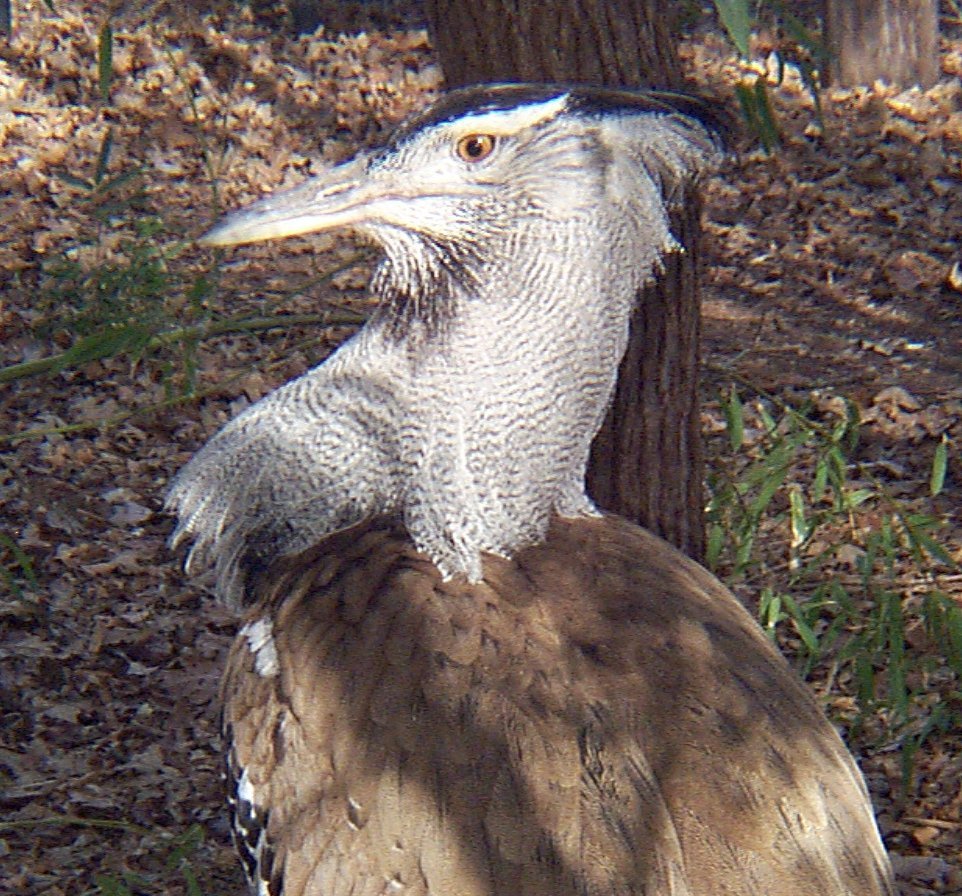
Kori Bustard
Closer view
of head feathers |
When you go to the zoo, take a look
at the feathers on the Kori
bustard. What different kinds of feathers can you see on this bird? How
long and wide are its different feathers? How are the feather barbs arranged?
Which ones don't have a zipped-together feather vane? How many different kinds
of feathers can you find on the
African crowned
cranes? What do you think might be the function of these different kinds of
feathers? |
|
Some birds have what looks like a
bright red patch of feathers, but which is actually bare skin through which you
can see blood flowing under the skin. This is the case in the
red-crowned
cranes. What about the red patch on the African crowned crane? Is their red
patch skin or feathers? As you look around the zoo, you might make a list of
birds with red skin patches. |
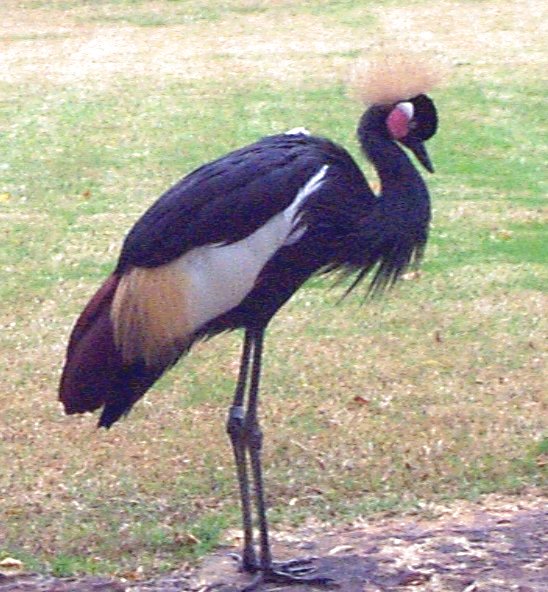
West African
Crowned Crane |
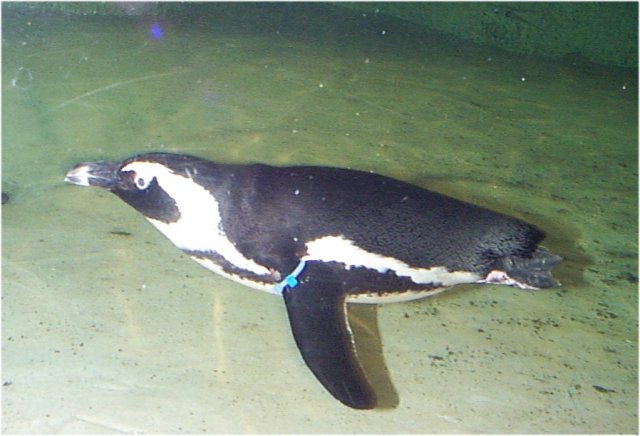
African Penguin |
Walk over to the aquarium to get a
close look at the penguins. How
are their feathers similar to or different from those of the
white pelicans in the same
exhibit? Watch the penguins through the underwater port. Are they swimming or
flying? |
Bird feathers come in many colors, from inconspicuous
browns and grays to dazzling red, blue or green. Feathers are colored in different
ways. In some feathers, pigment synthesized by the feather-producing cells is
deposited in the feather as it forms. These pigments are different kinds of
melanin, which can be either almost black or a reddish-brown color. In some
feathers, the bird doesn't make the pigment at all, but gets its feather color
out of its food. 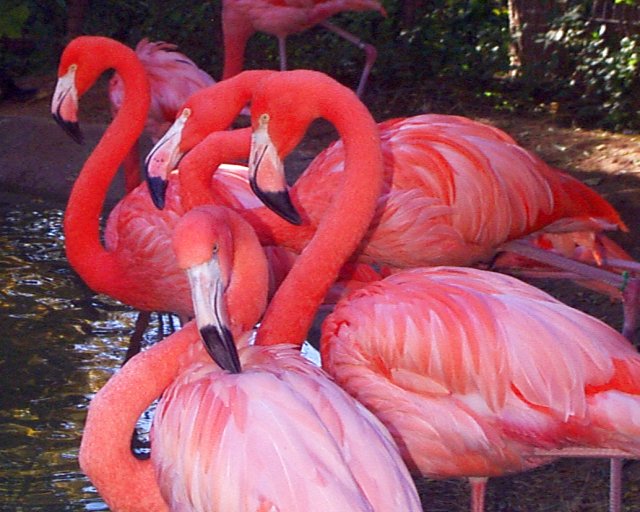 The
feathers of flamingos, ibises
and spoonbills
are colored with carotenoid (red and orange) pigments found naturally in small
crustaceans. However, to keep the feathers of these birds bright, their zoo
diet is supplemented with carotenoids.
The
feathers of flamingos, ibises
and spoonbills
are colored with carotenoid (red and orange) pigments found naturally in small
crustaceans. However, to keep the feathers of these birds bright, their zoo
diet is supplemented with carotenoids.
Some birds change the color of their feathers
during the breeding season. For example, here is the breeding
plumage of this yellow-billed
stork. Also compare this brown
pelican in June and September.
Some of the brightest feathers are a sort
of optical trick. The surface of the feather has microscopic ridges, like the
surface of a CD. Light striking the ridges is broken up like light passing
through a prism, and the color of the bird depends on the wave-length of the
light leaving the feather. Because this is similar to what happens when light
is diffracted through water droplets to make a rainbow, this kind of color is
called iridescence (Iris is the Greek goddess of the rainbow). Blue and green
feathers are nearly always produced by iridescence, as well as some brilliant
reds and yellows. The color of the blue feather above is this kind of color.
Curiously enough these feathers must have melanin in order to project their
blue structural color. When you go to the zoo, go to see the
hyacinth macaw and
the scarlet macaw. What kind
of color do you think these birds have?
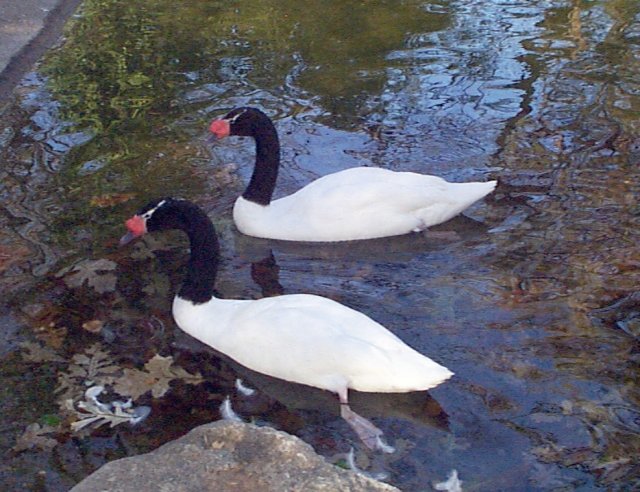 You may have heard the saying
"Birds of a feather flock together." What does "of a feather" mean in this
saying? Is the saying true? Go to the waterfowl areas near the aquarium, or to
the flamingo exhibit, where there are several different species of birds. Do
birds with similar feathers seem to keep together? If this is the case, why
might it be a useful thing to do? How do you think they recognize each other?
In the black-necked
swans, the male and female look very much alike. Is this the case in all
birds? As you look around the zoo, identify other bird species in which the
male and female look similar as well as some bird species in which the male and
female look different. Males and females of a species looking different is
called sexual dimorphism (di = two; morph = form). Since much of a bird's
appearance depends on its feathers, sexual dimorphism is partly due to males
and females having different kinds of feathers. Look at the female and male
Malaysian fireback
pheasant. How are the male's feathers different from the
female's feathers?
You may have heard the saying
"Birds of a feather flock together." What does "of a feather" mean in this
saying? Is the saying true? Go to the waterfowl areas near the aquarium, or to
the flamingo exhibit, where there are several different species of birds. Do
birds with similar feathers seem to keep together? If this is the case, why
might it be a useful thing to do? How do you think they recognize each other?
In the black-necked
swans, the male and female look very much alike. Is this the case in all
birds? As you look around the zoo, identify other bird species in which the
male and female look similar as well as some bird species in which the male and
female look different. Males and females of a species looking different is
called sexual dimorphism (di = two; morph = form). Since much of a bird's
appearance depends on its feathers, sexual dimorphism is partly due to males
and females having different kinds of feathers. Look at the female and male
Malaysian fireback
pheasant. How are the male's feathers different from the
female's feathers?
Although feathers can be used for many
other purposes in birds, we usually associate feathers with flying. One feather
specialization allows owls to fly very quietly. Look at feathers of the
great horned owl.
Owls have fringes at the edge of their feathers that muffle the sound of the
air passing over the wing as the bird flies low to the ground looking for prey.
The feathers around its eyes also help funnel sound towards its ears when it
hunts at night. Reducing the sound of its own wings makes it easier for the owl
to hear the sounds of potential prey.
To what bird do these feathers belong? 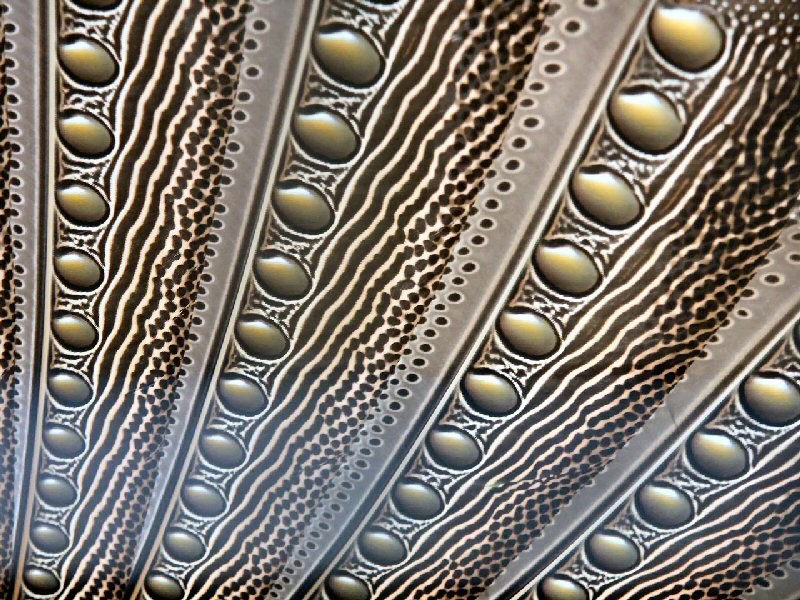 Click
here to see the bird these feathers came from. What is unusual about these
feathers? What other kinds of feathers can
you see on this bird?
Click
here to see the bird these feathers came from. What is unusual about these
feathers? What other kinds of feathers can
you see on this bird?
How many kinds of feathers did you see
looking at the birds of the Fort Worth Zoo? Did you discover special kinds of
feathers not mentioned in this ZooPax? If you see a specialized feather that
you think should be added to this ZooPax, E-mail
zoopax@whozoo.org. If your feather
suggestion is used, we will give you and your school a credit and identify your
contribution.


